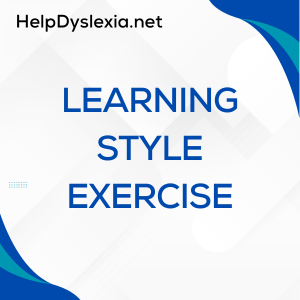Identifying the deep and underlying causes of learning disabilities doesn’t have to be difficult. A “Learning Style Exercise helps bring to the surface potential causes for many common learning disabilities including dyslexia (difficulty understanding words, sentences, or paragraphs),
dyscalculia (difficulty solving mathematical problems and grasping mathematical concepts, and auditory and visual processing disabilities.
There are many other disabilities as well that affect people from all walks of life. The important thing is that these learning disabilities often are masked behind weak cognitive skills.
The exercise can pinpoint exactly what cognitive skill is weak, and will give a qualified tutor the knowledge they need to create a plan of action to help the student strengthen the weak skill. Working on strengthening weak cognitive skills will dramatically increase effectiveness of the individual when it comes to learning. Simply, if a student is compensating for weak cognitive skills by relying on his or her strong cognitive skills, a “Learning Styles Exercise” will reveal this underlying pattern and allow for corrective action.
Studies have revealed that more than 80% of learning struggles come from weak underlying cognitive mental skills. That is why cognitive based testing, like a “Learning Styles Exercise”, is the most proven and effective way to start someone on the path to improved learning.
With a learning style exercise the main focus is on the main processing areas in the brain. A scoring system is used by quality testing and learning centers to help better identify potentially weak or strong skills. Higher scores in a certain area typically will mean they are a root cause for a learning issue. The processes focused on in this exercise include attention, processing speed, auditory processing, visual
processing, and logic and reasoning.
Here are your instructions so you can conduct a small sample “Learning Styles Exercise”: “Compared to kids the same age and gender, this behavior occurs _________ in my son or daughter.” Rank each statement on a scale of “0” to “4” as follows: (0) less often OR doesn’t apply at this age; (1) at about the same frequency; (2) slightly more; (3) considerably more; or (4) significantly more. You would rank where your child stands on topics such as attention, processing speed, auditory processing, memory, visual processing, and logic. Each of those main categories would have a variety of sub categories that you would work from.
After you are done you would add up each category. A score of 6 or below would suggest a normal range for that particular skill set, scoring 7 to 9 points out potential weaknesses, 10 to 11 shows a likely weakness, and 12 or above suggests a significant weakness.
Once you have conducted your own assessments it is important to go to a qualified learning center for a more thorough assessment of your child’s particular situation.
About the Author
LearningRx, www.learningrx.com, is a child and adult learning center which provides cognitive skills learning assessments and training to help students overcome learning disabilities.


